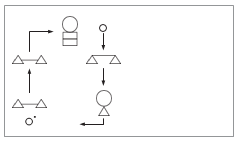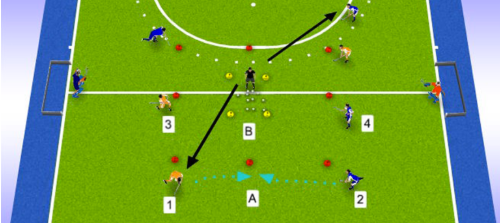Hockey drills
- 30 sec jumping jacks
- 30 sec sit ups
- 30se squats
- 30 sec push up and turn arm up
- 30 sec high knee running in place
- 30 sec lunges
- 30 sec plank
- knee lift
- heels against buttocks
- lateral steps both ways
- cross pass both sides
- ball retrieval
- 3 steps forward , backward and sprint
- 30 sec jumping jacks ( cfr army)
- 30 sec sit ups
- 30 sec squats
- 30 sec push-ups and arm twists
- 30 sezc high knee running in place
- 30 sec lunges
- Float along the outside of the square.
- Not only looking at the ball but also looking forward/around you.
- In the room are hoops.
- 2 teams play against each other.
- You can score a point by passing the ball 5 times and then putting the ball in a hoop.
- The other team can then take the ball.
- Push the ball to the right.
- play left
- slide
- lay down several hoops and per 3 players pass the ball 6 times at 1 hoop and then to the next hoop.
- Float the ball and after the hoop pass the ball to a teammate who does the same.

- With the different materials you can make nice courses.
- A course is a fun and fast way to get the children to repeat their skills.
- It is also possible to make courses with a certain theme.
- Possible themes are: drifting, slalom, passing, playing high, making tempo.
- The arrows and traffic signs can be used in all sorts of exercises in a course and in relays.
- Here are some examples of possible courses

- The catcher must try to catch the others.
- When you are tagged, you stand with your legs apart and your arms crossed.
- Without the ticker knowing, the group has appointed a secret saviour;
- He may redeem the ticked by secretly tapping them.
- The game stops when the secret deliverer is caught.

- Set up the exercise and where the ball is played to the team-mate it goes through the alley.
- At the end of the exercise the ball carrier can score on goal.
- After the exercise, the players walk along the outside back to the start.
- Increase the distance between them
- Make the street narrower and narrower
- change the starting position after a while

OrganizationField
: half field
Implementation
General
- Play direction of the game
- Goals in the middle of the field to stimulate awareness of the context of the game (from where do I defend, where do I score?).
- 1:1 : the trainer plays a ball to Orange 1 or Blue 2. Defender's goal is to prevent a goal and score himself.
- 2:1 : The trainer plays a ball to Orange 1 or Blue 2. When Orange 1 gets the ball, Orange 3 can join in the playing field of Orange 1
- Orange 1 and 2 play a 2:1 on Blue 4 (same if Orange 3 gets the ball (Section B)).
- 2:2 : Same as 2:1, but if Blue 2 gets the ball, Blue 4 may join the attack in the section of Orange 1 (Section A).
Tips on ball possession - Perform a feint when passing.
- Cut in after the passing action; protect the ball from the defender.
Tips on non-ball possession
- Find your opponent as quickly as possible.
- Keep your stick on the ball.
- Keep the opponent in front of you (on the forehand).
- ps changeover
At loss of ball:
- Put direct pressure on the ball handler, cut the shortest path to the goal.
On winning the ball:
- Perform a quick action/goal attempt towards goals.
- Making it easier
- Change the start location regularly.
Make it more difficult
- Vary the speed of throw.

- Orange 1 passes to Blue 2.
- Blue 2, 3, 4 try to score in the 2 little goals on the back line.
- Orange 1 tries to get in possession of the ball by defending on its strong side (fh). If he succeeds, he can score in the goal on the middle line (1½ meter wide).
- The exercise is started again when:
- Blue scores in 1 of the 2 goals on the back line at Orange.
- Orange 1 scores in the conversion in the goal of Blue.
- The ball goes over the back line.
Tips Ball possession
- Threaten with the ball and speed towards the goal.
- Look at each other as attackers when offering the ball.
- Help the ball carrier by running away from the ball.
Tips on no ball possession
- Guide with stick on the ground, forehand at ball height.
- Stay out of the ball carrier's physical space.
- Keep the ball on your forehand side. or v2 to create a 1:2 situation (double).
Passing tips
- At loss of possession: Pressure the ball immediately, cut off the shortest path to the goal.
goal.
- When gaining the ball: Keep the ball in quick action/goal attempt towards the goal.
Make it more difficult
- Use 1 goal instead of 2.
- Vary the tackling.







